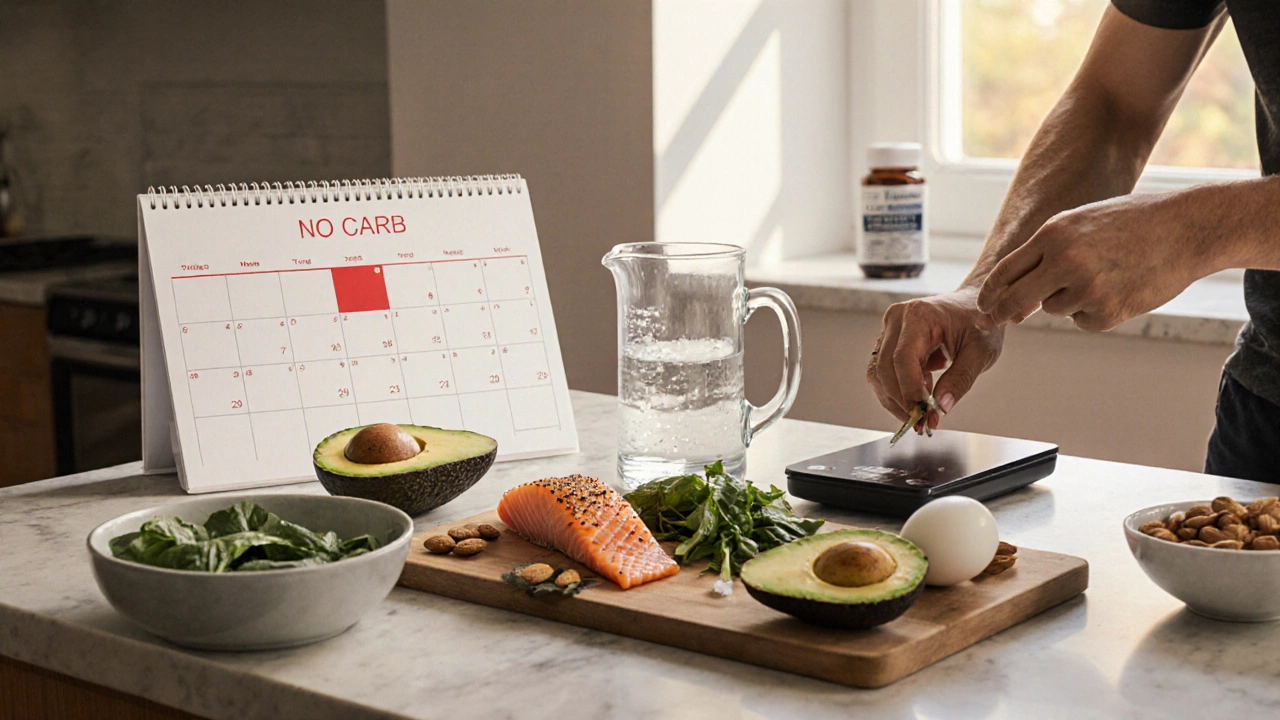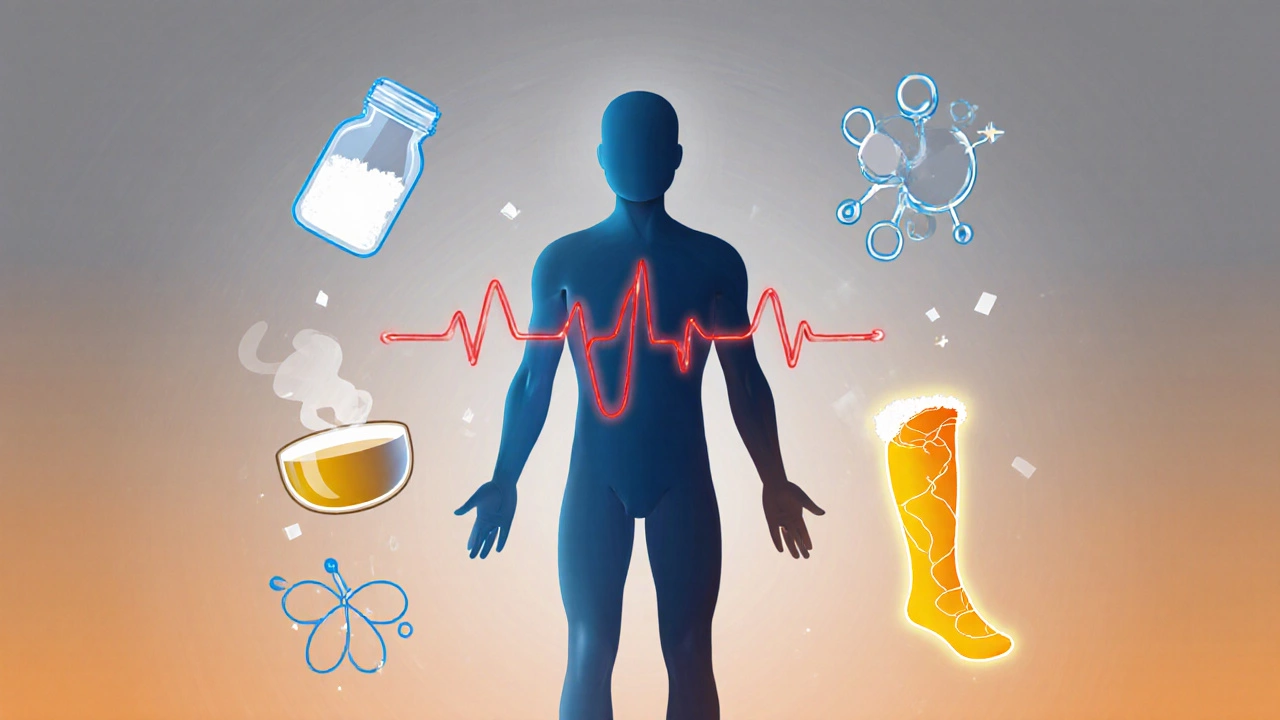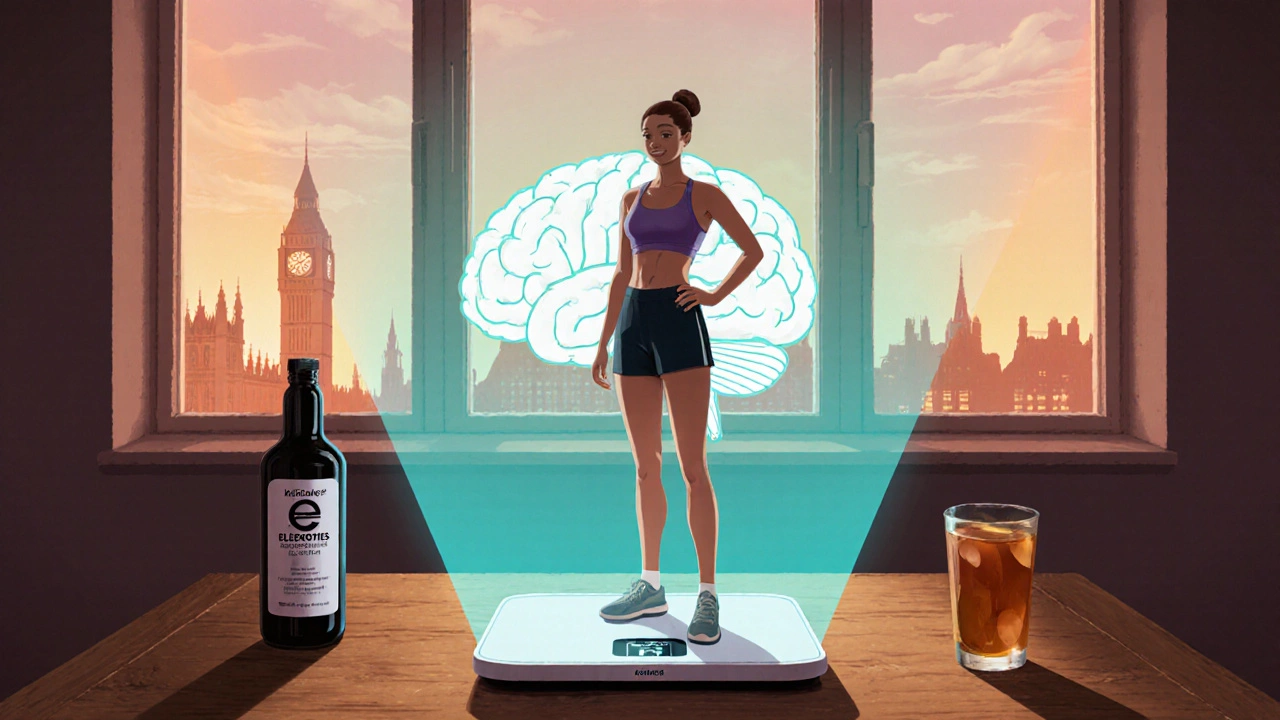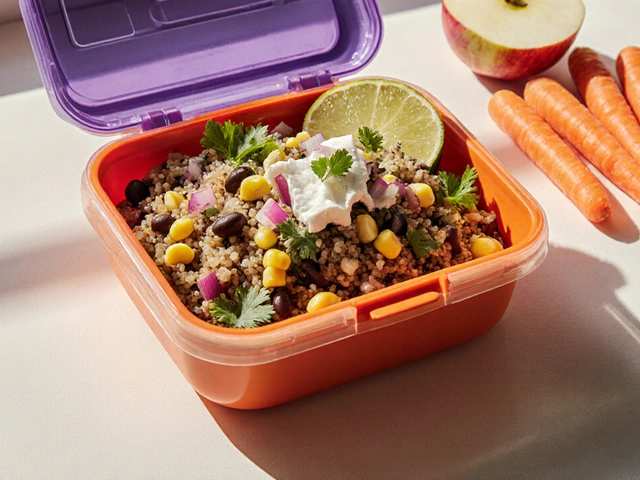
Electrolyte Calculator for Carb-Free Diet
Daily Electrolyte Needs
Symptom Tracker
Check symptoms you're experiencing:
Your Recommendations
Warning: Check with a healthcare provider if experiencing multiple symptoms above.
Ever wonder what your body does when you cut out no carbs for seven days straight? It’s a bold experiment that many try to jump‑start weight loss or reset their metabolism, but the results can be surprising, uncomfortable, or even risky if you’re not prepared. Below we break down exactly what happens inside your body day by day, why you might feel the classic "keto flu," and how to stay safe while you’re in the deep end of a carb‑free week.
Key Takeaways
- Within 24‑48 hours you’ll deplete liver and muscle Glycogen, triggering the onset of ketosis.
- Typical side‑effects include headache, fatigue, and cravings - often called the "keto flu."
- Staying hydrated and replenishing electrolytes (sodium, potassium, magnesium) can dramatically reduce discomfort.
- Most people see lower blood‑sugar spikes and modest weight loss after a week, but long‑term sustainability depends on nutrient balance.
- Watch for warning signs like persistent dizziness, rapid heart rate, or extreme mood swings - they may signal electrolyte imbalance or too‑low blood sugar.
What a "No‑Carb" Week Looks Like
First, let’s clarify the term. A Low‑carb diet is a nutritional plan that limits carbohydrate intake to typically under 20‑30 grams per day, emphasizing fats and moderate protein. When you go completely carb‑free, you essentially push your body into a state of Ketosis where the liver converts fatty acids into ketone bodies (β‑hydroxybutyrate, acetoacetate, acetone) for fuel. This metabolic shift is the core of the experiment.
Day‑by‑Day Physiological Changes
| Day | Primary Metabolic Shift | Common Symptoms | Blood Markers (approx.) |
|---|---|---|---|
| 1‑2 | Rapid Glycogen depletion, decreased Insulin secretion | Hunger spikes, irritability, mild headache | Glucose 70‑90 mg/dL, Insulin ↓ 30‑40% |
| 3‑4 | Onset of Ketosis; ketone bodies appear in blood | Fatigue, "keto flu", muscle cramps | β‑hydroxybutyrate 0.5‑1.5 mmol/L |
| 5‑6 | Adaptation phase - brain begins using ketones efficiently | Improved mental clarity, reduced appetite | β‑hydroxybutyrate 1.5‑3.0 mmol/L |
| 7 | Steady‑state ketosis; fat oxidation dominates | Stable energy, possible weight loss of 0.5‑1 kg (water + fat) | Glucose 65‑85 mg/dL, Ketones 2‑4 mmol/L |

Why the "Keto Flu" Happens
The term "keto flu" isn’t a medical diagnosis; it’s a cluster of symptoms caused by three main factors:
- Electrolyte loss. When glycogen stores shrink, they release water and electrolytes, especially sodium. Without proper replacement, you feel dizzy and crampy.
- Reduced insulin. Lower insulin levels make the kidneys excrete more sodium, amplifying the electrolyte deficit.
- Transition to ketones. Your brain and muscles are still learning to burn ketones, which can temporarily feel like low‑energy fatigue.
Simple fixes include adding a pinch of sea salt to meals, sipping broth, or supplementing magnesium (300‑400 mg) and potassium (2‑3 g) if you’re prone to cramps.
Potential Benefits After One Week
Even a short carb‑free stint can yield measurable gains:
- Weight loss. Most of the initial drop is water weight, but a modest 0.5‑1 kg of fat loss is common if you maintain a slight calorie deficit.
- Blood‑sugar stability. With minimal carbs, post‑meal glucose spikes disappear, which can be protective for pre‑diabetics.
- Appetite control. Ketone bodies are appetite‑suppressing, often reducing overall calorie intake.
- Clearer mental focus. Many report sharper concentration after the adaptation phase, likely because the brain has a steady ketone supply.

Risks & Red Flags to Watch
Going carb‑free isn’t for everyone. Keep an eye on these warning signs:
- Dizziness or fainting. Could signal severe electrolyte loss or hypoglycemia.
- Rapid heart rate or palpitations. A sign your body is struggling with sodium balance.
- Persistent nausea or vomiting. May indicate that your gut needs some carbs to function.
- Excessive fatigue after day 4. If you’re not moving past the "keto flu" after a week, you might need to reintroduce a modest amount of carbs.
If any of these occur, consider adding 20‑30 g of low‑glycemic carbs (berries, leafy greens) or ending the experiment early.
Tips for a Safer Carb‑Free Week
- Hydrate aggressively. Aim for at least 2.5 L of water daily, plus electrolytes.
- Salt your food. A teaspoon of sea salt spread across meals replaces lost sodium.
- Include nutrient‑dense fats. Avocado, olive oil, fatty fish, and nuts keep calories up without carbs.
- Monitor your body. Simple home ketone strips or a blood ketone meter can reassure you that you’re in ketosis.
- Plan meals ahead. Having ready‑made low‑carb options prevents accidental carb sneaks.
- Consider a gradual reduction. If a full week feels too harsh, drop carbs by 10 g each day for a smoother transition.
Frequently Asked Questions
Can I lose fat in just one week without carbs?
Yes, many people shed 0.5‑1 kg of fat in a seven‑day carb‑free stretch, especially if they keep protein moderate and calories slightly below maintenance. Most of the early weight loss is water, but the metabolic shift encourages fat burning.
Do I need to count calories while on a no‑carb diet?
Not strictly, but tracking calories can help you avoid accidentally overeating fats, which can stall weight loss. A rough range of 1,800‑2,200 kcal for most adults works as a starting point.
Is a week without carbs safe for athletes?
High‑intensity athletes rely on glycogen for quick bursts, so a full carb cut can impair performance. If you train heavily, consider a targeted ketogenic approach-carbs around workouts while staying low the rest of the day.
What foods are safe to eat on a no‑carb week?
Focus on meat, fish, eggs, full‑fat dairy, non‑starchy veg (spinach, broccoli, zucchini), nuts, seeds, oils, and broth. Avoid grains, fruit (except tiny berries), starchy veg, legumes, and sugar.
How do I know if I’ve entered ketosis?
Common signs are reduced appetite, clearer thinking, and a slight metallic taste. For objective proof, use urine strips (ketone level > 2 mmol/L) or a blood meter measuring β‑hydroxybutyrate.
Going carb‑free for a week is a powerful experiment that can reveal how adaptable your metabolism truly is. By staying hydrated, balancing electrolytes, and listening to your body, you can navigate the rough first few days and reap the benefits of steady ketosis. If the side‑effects feel too intense, don’t force it-gradual reduction or a moderate low‑carb plan can still deliver health improvements without the shock to your system.





